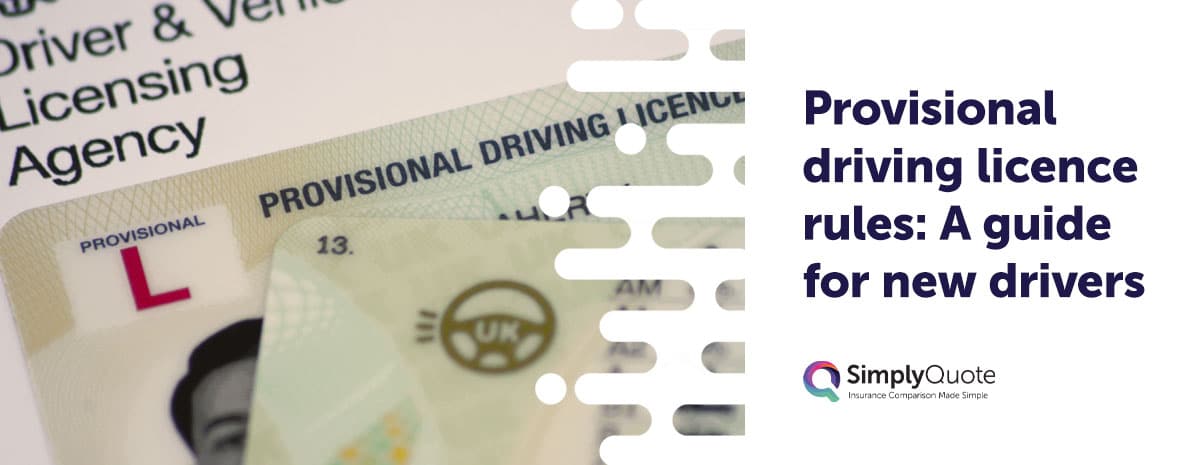Provisional driving licence rules: A guide for new drivers
Earning a provisional driving licence is a major milestone, marking the first step toward driving independence in the UK. Whether you’re preparing for lessons or practising with a supervising driver, it’s essential to understand the rules, responsibilities, and requirements to stay safe and legal on the road.
In this guide, we’ll cover everything you need to know about provisional licences, from how to apply and key rules to the importance of insurance and preparing for your driving tests.
We’ve also included surprising statistics about provisional licence holders to give you a full picture of the challenges and responsibilities that come with learning to drive.

What is a provisional driving licence?
A provisional driving licence is a learner’s permit that allows you to legally drive on UK roads under specific conditions while preparing for your full driving licence.
It gives you the freedom to practice driving with supervision and is also required to book your theory and practical tests.
While provisional licences open up new opportunities, they also come with risks and responsibilities. For example, 77,402 provisional licence holders had accumulated penalty points in 2020, with a total of 419,449 points issued.
Surprisingly, the UK’s most dangerous learner driver, a 43-year-old man, amassed 63 penalty points as of 2023. Adhering to the rules is crucial to avoid penalties and ensure a smooth driving journey.
Looking for learner driver insurance? Get your quote today!
Get QuotesWhat do I need to get a provisional licence?
Applying for a provisional driving licence is simple, but you need to meet specific requirements and have the right documentation.
Key Requirements
- Age: You must be at least 15 years and 9 months old to apply.
- Residency: You must have lived in Great Britain for at least 185 days in the past year.
- Vision Test: You must be able to read a standard number plate from 20 metres away.
Documents Needed
- A valid UK passport or other acceptable identification.
- Your National Insurance number (if applicable).
- Addresses of where you’ve lived for the past three years.
Cost
The application fee is £34 online or £43 by post, making it accessible for most new drivers.
Once your application is approved, your licence should arrive within one week, allowing you to start preparing for lessons and practice.
What are the rules for provisional licence holders?
Driving with a provisional licence comes with specific rules to ensure safety and compliance with UK law. Breaking these rules could result in fines, penalties, or even losing your licence before earning your full one.
Supervision Requirements
You must always be supervised by a qualified driver who:
- Is at least 21 years old.
- Has held a full UK driving licence for at least three years.
The supervising driver must sit in the front passenger seat at all times.
L Plates
- You must display L plates (or D plates in Wales) clearly on both the front and back of your vehicle.
- Failure to display L plates can result in fines or invalidate your insurance.
Motorway Driving
- You can only drive on motorways with an approved driving instructor in a car fitted with dual controls.
Insurance Requirements
Driving without insurance is illegal. In 2020, 14,618 provisional licence holders were caught driving uninsured, marking a 16% increase compared to previous years. Learners can either:
- Take out learner driver insurance.
- Be added as a named driver to an existing policy.
Penalty Risks
Provisional licence holders are not exempt from penalty points. For example, 81% of learner drivers with points are male, with drivers aged 20-29 being the most likely to face penalties.
Following these rules will help you learn safely, avoid penalties, and build confidence on the road.
Do I need insurance with a provisional licence?
Yes, having valid insurance is a legal requirement for all provisional licence holders. Driving without insurance could result in fines, penalty points, or even a driving ban.
Insurance options for learners
- Learner Driver Insurance: Ideal for those practising in a family member’s or friend’s car, this short-term policy ensures the vehicle owner’s no-claims discount is protected.
- Named Driver Policy: Allows you to be added to an existing car insurance policy, but a claim could impact the main driver’s no-claims bonus.
- Driving Instructor Insurance: Professional driving instructors usually have their vehicles insured for learners.
Choosing the right insurance ensures you’re legally covered and financially protected as you learn.
How long is a provisional licence valid?
Your provisional driving licence is valid for 10 years from the date it’s issued. This gives you plenty of time to prepare for your theory and practical tests.
What happens if it expires?
- You’ll need to apply for a renewal to continue learning and driving legally.
- Delays in renewing your licence can set back your progress, so keep track of its expiration date.
Planning ahead ensures you don’t face unnecessary interruptions on your journey to becoming a fully licensed driver.
Related Read: How to renew an expired driving licence in the UK
How to prepare for your theory and practical tests
Passing your theory and practical driving tests is a crucial step toward becoming a fully licensed driver. Preparing thoroughly for both tests will not only improve your chances of success but also make you a safer and more confident driver.
Preparing for the Theory Test
The theory test is designed to assess your knowledge of the rules of the road, road signs, and safe driving practices. It has two parts:
The first part, multiple-choice questions, tests your understanding of driving laws, road signs, and hazard awareness. You’ll answer 50 questions and need a score of at least 43 to pass.
The second part, the hazard perception test, involves watching 14 video clips and identifying developing hazards. The pass mark is 44 out of 75.
How to prepare:
- Study the Highway Code thoroughly, as most questions are based on it.
- Use practice resources like the DVSA Theory Test Kit App or online mock tests.
- Practise hazard perception tests to improve your ability to spot risks early.
Preparing for the Practical Test
The practical test evaluates your ability to drive safely and competently in real-world scenarios. It typically lasts around 40 minutes and includes:
- Vehicle Safety Questions (“Show Me, Tell Me”): You’ll answer questions about vehicle maintenance and safety.
- Driving Skills Assessment: You’ll demonstrate smooth control, correct gear use, and awareness of other road users.
- One Manoeuvre: This could include parallel parking, reversing into a bay, or pulling up on the right and reversing.
- Independent Driving: You’ll follow either sat nav instructions or traffic signs for about 20 minutes.
Tips for success:
- Practise consistently with an approved instructor.
- Drive in various conditions (e.g., night driving, rain) to gain confidence in all scenarios.
- Familiarise yourself with routes near your test centre.
- Perfect key manoeuvres and learn to stay calm under test conditions.
By following these steps, you’ll be well-prepared for both your theory and practical tests, ensuring you’re ready for the challenges of driving independently.
Final thoughts
Holding a provisional driving licence is an exciting step toward becoming an independent driver. With over 2.1 million provisional licence holders in the UK, you’re part of a large community taking the first steps toward driving freedom.
By following the rules, staying insured, and preparing thoroughly for your tests, you’ll set yourself up for success and safety on the road. Take your time, practise consistently, and ensure you’re well-prepared for every stage of the journey.
Frequently Asked Questions (FAQs)
Yes, but only if accompanied by an approved driving instructor in a dual-controlled car.
Most applications are processed within a week if done online.
Yes, any penalty points on your provisional licence will transfer to your full licence once obtained.
You can start driving at 17 years old, provided you meet all requirements, including insurance and supervision.
Yes, most learner-specific policies ensure the vehicle owner’s no-claims discount remains unaffected.
£34 if applying online, or £43 if applying by post.
Yes, you can renew your provisional licence if it expires, but renewal fees apply.
Yes, a provisional licence is required for motorbike training and tests, along with completing CBT.
